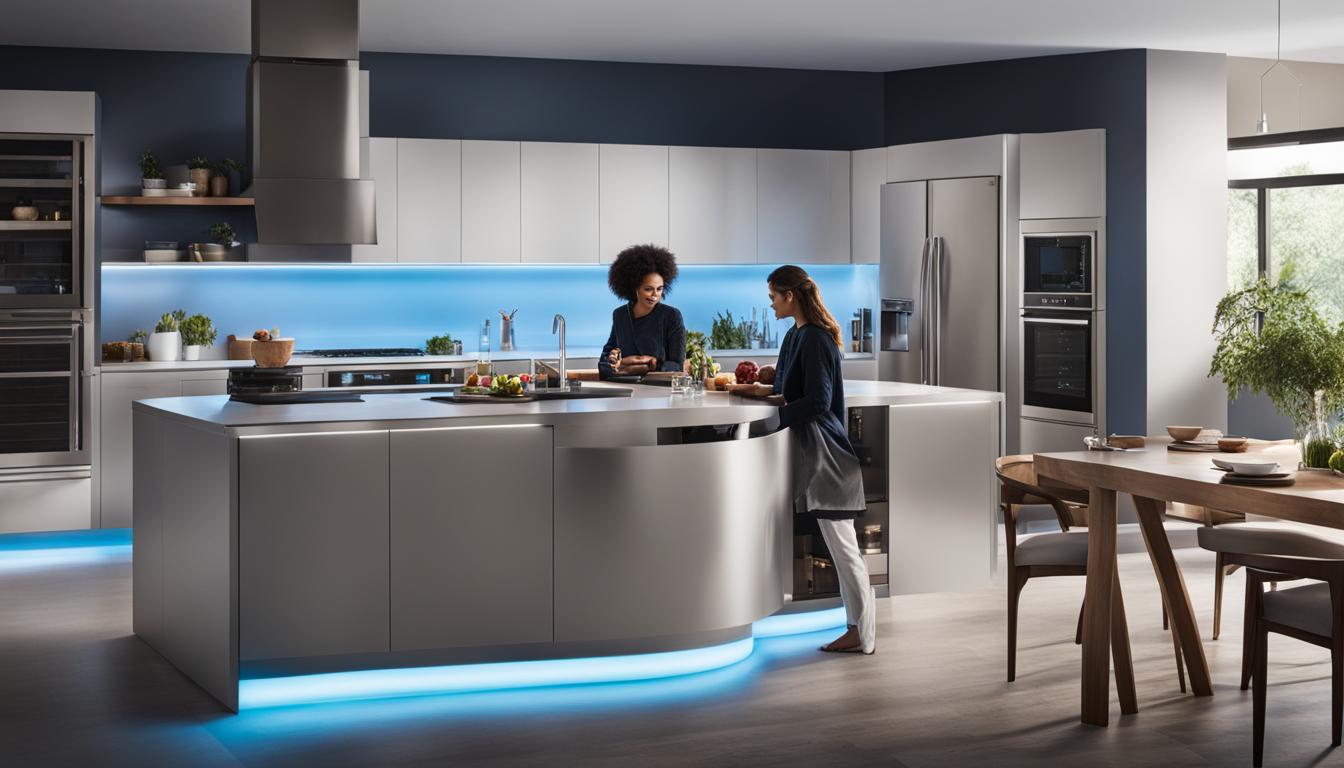Are you prepared to elevate your smart home experience? Look no further as we provide four crucial tips for seamlessly incorporating smart home appliances.
From choosing compatible devices to optimizing energy efficiency, we’ll guide you through the process of creating a seamless and efficient smart home system.
Our first tip is all about choosing devices that work well together, ensuring a smooth integration.
Next, we’ll show you how to set up a central hub, the heart of your smart home.

Security is crucial, so we’ll also walk you through establishing a secure network.
Lastly, we’ll discuss the importance of using a smart home automation platform to customize and control your system.
Get ready to master the art of smart home integration!
Key Takeaways
- Research and verify compatibility between smart home devices and existing hub or control system
- Read reviews and do thorough research before purchasing smart home appliances to avoid compatibility issues
- Ensure regular updates of firmware and software for both appliances and system to improve compatibility and performance
- Seek professional assistance if facing complex integration problems for seamless integration of smart home appliances
Choose Compatible Devices
When integrating smart home appliances, we need to ensure that we select devices that are compatible with each other. Choosing compatible devices is crucial to the successful integration and smooth functioning of your smart home system. In order to do so, there are a few key factors to consider.

Firstly, it’s important to research and understand the different communication protocols used by smart home devices. Common protocols include Wi-Fi, Bluetooth, Zigbee, and Z-Wave. Ensuring that your devices use the same protocol will prevent any connectivity issues and allow them to seamlessly communicate with each other.
Secondly, check for compatibility with your existing smart home hub or control system. Some devices may only be compatible with specific hubs or platforms, so it’s important to verify this before making a purchase.
Lastly, consider the brand and manufacturer of the devices you’re selecting. Some brands have a reputation for producing products that work well together, while others may have compatibility issues. Reading reviews and doing thorough research can help you make an informed decision.
By carefully choosing compatible devices, you can avoid common issues such as devices not connecting or working together properly. This will ensure a hassle-free experience and maximize the functionality of your smart home system.

Now that we’ve discussed the importance of choosing compatible devices, let’s move on to the next step: setting up a central hub.
Set up a Central Hub
When it comes to integrating smart home appliances, setting up a central hub is essential.
This hub acts as the command center for all your devices, ensuring compatibility, efficient connectivity, and ease of control.
Compatibility of Devices
To ensure seamless integration of smart home appliances, we recommend setting up a central hub to facilitate compatibility between devices. Device compatibility and connectivity are crucial factors for the effective functioning of your smart home ecosystem.

A central hub acts as a control center, allowing you to connect and manage all your devices from a single interface. It serves as a bridge between different devices, enabling them to communicate and work together seamlessly. By connecting your devices to a central hub, you can avoid compatibility issues and ensure that all your smart appliances work harmoniously. This centralized approach simplifies the management of your smart home and enhances the overall user experience.
Now that we’ve discussed the importance of setting up a central hub for device compatibility, let’s move on to the next section, which focuses on placement and connectivity.
Placement and Connectivity
We highly recommend setting up a central hub for seamless placement and connectivity of smart home appliances. When considering the placement of your smart home devices, there are a few important factors to keep in mind:
- Coverage: Ensure that your central hub is strategically placed to provide optimal coverage throughout your home. Consider the layout and size of your space to determine the best location for your hub.
- Interference: Avoid placing the hub near sources of interference, such as large appliances or Wi-Fi routers. This will help minimize connectivity issues and ensure smooth operation of your smart home devices.
- Connectivity options: Look for a central hub that offers a wide range of connectivity options, such as Wi-Fi, Bluetooth, and Zigbee. This will allow you to connect and control a variety of smart home appliances from different manufacturers.
By taking these placement considerations and exploring different connectivity options, you can create a robust smart home system that meets your needs.

Now, let’s move on to the next section about the ease of control for your smart home appliances.
Ease of Control
Setting up a central hub is essential for easy control of your smart home appliances. By having a central hub, you can easily manage and control all your devices from one place, eliminating the need to use multiple apps or devices. This not only simplifies the control process but also enhances the overall user experience.
When choosing a central hub, look for one that offers ease of installation and a user-friendly interface. You want a hub that’s intuitive and straightforward to set up, allowing you to quickly connect all your devices and start controlling them effortlessly. A central hub with a user-friendly interface will ensure that you can easily navigate through the settings and customize your smart home according to your preferences.
With a central hub in place, you can now move on to the next step of establishing a secure network.

Establish a Secure Network
Our top priority is to ensure a secure network when integrating smart home appliances. Establishing a secure network is crucial to protecting your personal information and preventing unauthorized access to your devices.
Here are three essential tips to help you establish a secure network for your smart home:
- Secure your Wi-Fi network: Change the default username and password of your Wi-Fi router to a strong, unique combination. Enable encryption, such as WPA2, to ensure that your network traffic is encrypted and secure. Regularly update your router’s firmware to patch any security vulnerabilities.
- Use strong, unique passwords: Create strong and unique passwords for each of your smart home devices and services. Avoid using common words or easily guessable information. Consider using a password manager to securely store your passwords.
- Keep your devices up to date: Regularly update the firmware and software of your smart home devices. Manufacturers often release updates that address security vulnerabilities and improve device performance. Set up automatic updates whenever possible to ensure that your devices are always up to date.
Use a Smart Home Automation Platform
To further enhance the integration of smart home appliances, utilizing a comprehensive smart home automation platform is essential. A smart home automation platform serves as the central hub that connects all your smart devices and allows you to control them seamlessly from a single interface. By investing in a smart home platform, you can experience a multitude of benefits and take full advantage of the capabilities of your smart home appliances.
One of the key advantages of using a smart home platform is the convenience it offers. With a unified platform, you can easily control and manage all your smart devices, such as thermostats, lights, security cameras, and even kitchen appliances, from anywhere using your smartphone or voice commands. This level of control allows you to create customized schedules, automate routine tasks, and monitor your home remotely, providing you with peace of mind and saving you time and effort.

Moreover, a smart home platform enables interoperability between different brands and types of smart devices. This means that you can mix and match products from various manufacturers and still have them work seamlessly together. This flexibility allows you to choose the best devices for your specific needs, rather than being limited to a single brand or ecosystem.
In addition, a smart home platform often provides advanced features such as energy management and usage monitoring. By analyzing your energy consumption patterns, these platforms can help you optimize your energy usage, reduce your utility bills, and contribute to a more sustainable lifestyle.
Customize Your Smart Home System
Now let’s talk about how to personalize your smart home system.
By customizing device settings, we can ensure that our smart appliances operate according to our preferences.

This allows us to optimize home automation and create a tailored smart home setup that meets our specific needs and lifestyle.
Personalize Device Settings
One important step in integrating smart home appliances is to customize our device settings to meet our individual needs and preferences. By personalizing our device settings, we can optimize the functionality and performance of our smart home system.
Here are three key ways to personalize our device settings:
- Adjusting automation settings: We can customize our smart home devices to automate tasks based on our daily routines and preferences. This can include setting specific times for lights to turn on or off, adjusting thermostat settings for different times of the day, or scheduling our robotic vacuum cleaner to clean at specific intervals.
- Tailoring notifications: We can choose which notifications we want to receive from our smart home devices. Whether it’s receiving alerts for unusual activities, low battery levels, or updates on device status, we can customize these notifications to ensure they’re relevant and not overwhelming.
- Creating user profiles: Many smart home devices allow us to create multiple user profiles, each with its own preferences and settings. This is particularly useful when multiple family members are using the same smart home system, as each individual can have their own customized experience.
Optimize Home Automation
We frequently optimize our smart home system by customizing our home automation settings. This allows us to maximize convenience and implement energy-saving tips. By customizing our smart home system, we can create a personalized experience that aligns with our lifestyle and preferences. Here are three key areas where we can optimize our home automation settings:

| Area | Energy Saving Tips | Maximizing Convenience |
|---|---|---|
| Lighting | Use motion sensors and timers to automatically turn off lights | Create customized lighting scenes for different activities and moods |
| Temperature | Set schedules and use smart thermostats to regulate heating and cooling | Use occupancy sensors to adjust temperature based on room occupancy |
| Security System | Integrate smart locks and cameras to monitor and control access to our home | Set up alerts and notifications for any unusual activities or security breaches |
Tailor Smart Home Setup
To tailor our smart home setup, we customize our smart home system to fit our specific needs and preferences. Smart home customization allows us to create a personalized home automation experience that enhances our daily lives.
Here are three essential tips for customizing our smart home system:
- Identify our needs: Before diving into smart home customization, we should identify the areas of our home that require automation. Whether it’s controlling lights, thermostat, or security systems, understanding our needs will help us choose the right smart devices.
- Choose compatible devices: When customizing our smart home system, it’s crucial to select devices that are compatible with each other. This ensures seamless integration and allows us to control multiple devices from a single hub or app.
- Create personalized automation routines: We can take our smart home experience to the next level by creating personalized automation routines. This involves setting up specific triggers and actions that align with our daily routines and preferences.
Optimize Energy Efficiency
Our goal is to maximize energy efficiency when integrating smart home appliances. By implementing energy saving tips, we can significantly reduce electricity consumption and lower our carbon footprint.
Here are a few strategies to optimize energy efficiency in your smart home setup.

Firstly, consider investing in energy-efficient appliances. Look for appliances with high Energy Star ratings, as they’re designed to consume less electricity while delivering optimal performance. Additionally, make sure to properly configure your appliances’ energy-saving settings. Adjusting the brightness levels on your smart lights and dimming your smart thermostat during periods of low activity can help conserve energy.
Another effective way to optimize energy efficiency is by scheduling your smart appliances. Set your smart washing machine and dishwasher to operate during off-peak hours when electricity rates are lower. You can also automate the lighting in your home to turn off when no one is in the room or use motion sensors to activate lights only when necessary.
Lastly, monitor your energy consumption using smart energy monitoring devices. These devices provide real-time data on your energy usage, allowing you to identify areas where energy is being wasted and make the necessary adjustments.
By implementing these energy saving tips, you can reduce your electricity consumption and create a more sustainable smart home environment.

In the next section, we’ll discuss how to troubleshoot integration issues that may arise when integrating smart home appliances.
Troubleshoot Integration Issues
To address any potential challenges users may encounter when integrating smart home appliances, let’s now explore how to troubleshoot integration issues. Here are three troubleshooting tips to help you overcome common integration issues:
- Check for compatibility: Before integrating any new smart home appliance, ensure that it’s compatible with your existing smart home system. Check the specifications and requirements of both the appliance and the system to ensure they can work together seamlessly. If there are compatibility issues, consider contacting the manufacturer or consulting with a professional to find a solution.
- Reset and restart: If you’re experiencing integration issues, a simple solution is to reset and restart both the smart home appliance and the system. This can help resolve any temporary glitches or connectivity problems. Follow the manufacturer’s instructions on how to reset your devices and restart your system. After doing so, attempt to integrate the appliance again.
- Update firmware and software: Outdated firmware or software can cause integration issues. Regularly check for updates from the manufacturer and ensure that both your smart home appliance and system are running the latest versions. Updating firmware and software can improve compatibility, fix bugs, and enhance performance.
Frequently Asked Questions
What Are Some Common Integration Issues That Users May Encounter When Setting up Their Smart Home Appliances?
Common troubleshooting issues that users may encounter when setting up their smart home appliances include:
- Compatibility problems between different devices
- Connectivity issues with the home network
- Difficulties in configuring and syncing multiple devices
- Troubleshooting software glitches
To overcome these challenges, it’s important to follow best practices such as:

- Ensuring that all devices are compatible with each other
- Having a strong and reliable Wi-Fi network
- Carefully following setup instructions
- Regularly updating software for optimal performance.
Can I Control My Smart Home Appliances Remotely From My Smartphone or Computer?
Yes, we can control our smart home appliances remotely from our smartphones or computers. This feature allows us to conveniently manage and monitor our devices from anywhere.
The benefits of smartphone integration include the ability to turn appliances on or off, adjust settings, and receive notifications and alerts.
With remote control capabilities, we’ve greater control over our smart home appliances, making our lives more convenient and efficient.
How Can I Ensure the Security of My Smart Home Network and Prevent Unauthorized Access?
To ensure the security of our smart home network and prevent unauthorized access, we must take certain precautions.

Implementing strong passwords and regularly updating our devices’ firmware are crucial.
We should also enable two-factor authentication for an added layer of security.
Additionally, configuring our router’s firewall and disabling unnecessary features can help protect our network.
Are There Any Specific Energy-Saving Features or Settings That I Should Be Aware of When Using Smart Home Appliances?
When using smart home appliances, it’s important to be aware of energy-saving features and settings. These can help reduce energy consumption and save money on utility bills.

Some common energy-saving features include programmable timers, motion sensors, and power usage monitoring. It’s also worth exploring the settings of your smart home appliances to ensure they’re optimized for energy efficiency.
What Should I Do if I Experience Compatibility Issues Between My Smart Home Devices and My Central Hub?
If we encounter compatibility issues between our smart home devices and central hub, there are troubleshooting tips and compatibility solutions to consider.
First, we should ensure that all devices are using the latest firmware and software updates.
It’s also essential to check if the devices are compatible with each other and the central hub.

If issues persist, contacting the manufacturer’s support team or seeking professional assistance can help resolve the problem efficiently.
What Are Some Essential Tips for Beginners in Integrating Smart Home Appliances?
When beginning to integrate smart home appliances, start by researching a comprehensive smart home appliances guide. Understanding compatibility and connectivity is crucial. Select devices with user-friendly interfaces and invest in a strong Wi-Fi network. Always prioritize security measures and consider professional installation for complex systems.
Conclusion
In conclusion, by following these four essential tips for integrating smart home appliances, you can create a seamless and efficient smart home system.
Choose compatible devices, set up a central hub, establish a secure network, and use a smart home automation platform.
Customizing your system and optimizing energy efficiency will further enhance your experience.

And if any integration issues arise, don’t worry, troubleshooting is always possible.
With these steps, you can confidently embrace the convenience and benefits of a smart home.










